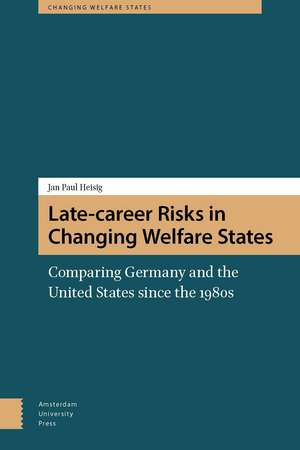Late-Career Risks in Changing Welfare States: Comparing Germany and the United States since the 1980s: Changing Welfare States
Autor Jan Paul Heisigen Limba Engleză Hardback – 23 iul 2015
Motivated by ongoing debates over welfare state retrenchment and growing economic insecurity, this book compares the situation of older workers in Germany and the United States over the past three decades. Both nations are seeing a rise in insecurity for older workers, but the differences in support programs, pensions, and retirement options have led to differing outcomes for workers faced with early retirement or job loss.
Preț: 593.99 lei
Preț vechi: 931.38 lei
-36% Nou
Puncte Express: 891
Preț estimativ în valută:
113.65€ • 118.68$ • 93.86£
113.65€ • 118.68$ • 93.86£
Carte indisponibilă temporar
Doresc să fiu notificat când acest titlu va fi disponibil:
Se trimite...
Preluare comenzi: 021 569.72.76
Specificații
ISBN-13: 9789089646774
ISBN-10: 9089646779
Pagini: 285
Ilustrații: 55 illustrations
Dimensiuni: 152 x 229 x 25 mm
Greutate: 0.64 kg
Editura: Amsterdam University Press
Colecția Amsterdam University Press
Seria Changing Welfare States
ISBN-10: 9089646779
Pagini: 285
Ilustrații: 55 illustrations
Dimensiuni: 152 x 229 x 25 mm
Greutate: 0.64 kg
Editura: Amsterdam University Press
Colecția Amsterdam University Press
Seria Changing Welfare States
Notă biografică
Jan Paul Heisig is a researcher at the Wissenschaftszentrum Berlin.
Cuprins
Acknowledgment
Part I: Background
Introduction
1.1 Why compare Germany and the United States?
1.2 Why study income mobility around job loss and retirement?
1.3 Overview of the study
2. Welfare state change and income mobility: a framework
2.1 Income mobility: relevance, limitations, and empirical approaches
2.2 Income mobility around adverse life events – a framework
2.3 The focal events: job loss and retirement
3. Institutional context and social policy change
3.1 Macroeconomic context
3.2 Differences and trends in the employment levels of older people
3.3 Institutional context and the (re)employment prospects of older workers
3.4 Differences and changes in public and employment-based protection
3.5 Female labor force participation and earnings arrangements
3.6 Summary
4. Data and methods
4.1 Conceptual framework and analytic strategy
4.2 Implementation of did matching and compositional adjustments
4.3 Data and key measures
Part II: Economic consequences of retirement
5. Literature review and research questions
5.1 Why should economic well-being change at retirement?
5.2 Institutional context and income changes at retirement: research questions and hypotheses
5.3 Previous research on income change at retirement
6. The changing economic consequences of retirement
6.1 Retirement patterns and economic situation of non-working individuals
6.2 Sample characteristics and details of estimation approach
6.3 Income changes around exit from work
6.4 Summary and conclusions
6.5 Additional results
Part III: Economic consequences of late-career job loss
7. Literature review and research questions
7.1 Employment, earnings and household income after late-career job loss
7.2 Institutional context and the impact of late-career job loss on employment and income: research questions and hypotheses
7.3 Previous empirical research
8. The changing economic consequences of late-career job loss
8.1 Sample characteristics and details of estimation approach
8.2 Empirical results
8.3 Summary and conclusions
8.4 Additional results
Part IV: Conclusion
9. Conclusion
9.1 Key findings: welfare regimes and the ‘Great Risk Shift’ revisited
9.2 Implications and directions for future research
List of acronyms
Bibliography
Index
Part I: Background
Introduction
1.1 Why compare Germany and the United States?
1.2 Why study income mobility around job loss and retirement?
1.3 Overview of the study
2. Welfare state change and income mobility: a framework
2.1 Income mobility: relevance, limitations, and empirical approaches
2.2 Income mobility around adverse life events – a framework
2.3 The focal events: job loss and retirement
3. Institutional context and social policy change
3.1 Macroeconomic context
3.2 Differences and trends in the employment levels of older people
3.3 Institutional context and the (re)employment prospects of older workers
3.4 Differences and changes in public and employment-based protection
3.5 Female labor force participation and earnings arrangements
3.6 Summary
4. Data and methods
4.1 Conceptual framework and analytic strategy
4.2 Implementation of did matching and compositional adjustments
4.3 Data and key measures
Part II: Economic consequences of retirement
5. Literature review and research questions
5.1 Why should economic well-being change at retirement?
5.2 Institutional context and income changes at retirement: research questions and hypotheses
5.3 Previous research on income change at retirement
6. The changing economic consequences of retirement
6.1 Retirement patterns and economic situation of non-working individuals
6.2 Sample characteristics and details of estimation approach
6.3 Income changes around exit from work
6.4 Summary and conclusions
6.5 Additional results
Part III: Economic consequences of late-career job loss
7. Literature review and research questions
7.1 Employment, earnings and household income after late-career job loss
7.2 Institutional context and the impact of late-career job loss on employment and income: research questions and hypotheses
7.3 Previous empirical research
8. The changing economic consequences of late-career job loss
8.1 Sample characteristics and details of estimation approach
8.2 Empirical results
8.3 Summary and conclusions
8.4 Additional results
Part IV: Conclusion
9. Conclusion
9.1 Key findings: welfare regimes and the ‘Great Risk Shift’ revisited
9.2 Implications and directions for future research
List of acronyms
Bibliography
Index



